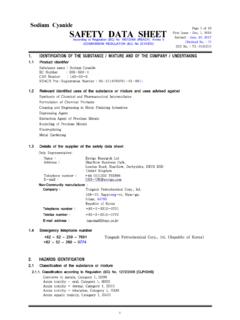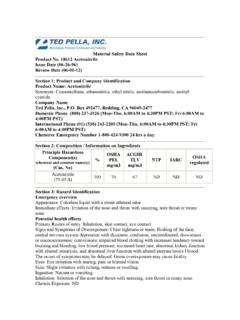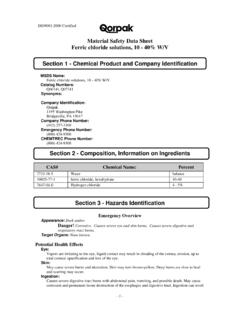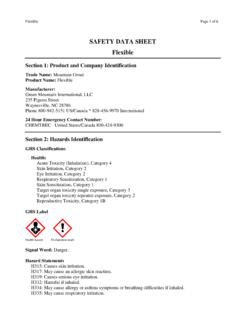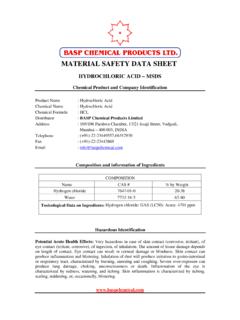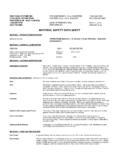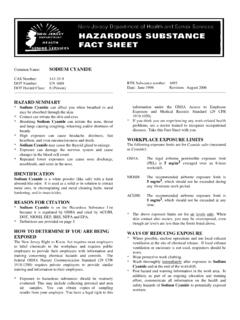Transcription of Sulfuric Acid 93% Safety Data Sheet (SDS)
1 Page 1 of 8 Sulfuric acid 93% Safety data Sheet (SDS) Health 3 Fire 0 Reactivity 0 Personal Protection 3 0 Section 1: Chemical Product and Company Identification Product Name: Sulfuric acid 93% CAS#: 7664-93-9 Synonym: Oil of Vitriol; Sulfuric acid Chemical Name: Hydrogen sulfate Chemical Formula: H2-SO4 Contact Information: Paramount Chemicals & Plastics, Inc. CCN 811901 Warehouse: 14470 S State Road 29 Felda, FL 33930 Phone: (863) 674-1800 Fax: (863) 674-1802 E-mail: CHEMTREC - 24 Hour Emergency Telephone- call: 1-800-424-9300 CCN 811901 Section 2: Composition and Information on Ingredients Composition: Name CAS # % by Weight Sulfuric acid 7664-93-9 93% Toxicological data on Ingredients: Sulfuric acid : ORAL (LD50): Acute: 2140 mg/kg [Rat.]. VAPOR (LC50): Acute: 510 mg/m 2 hours [Rat]. 320 mg/m 2 hours [Mouse]. Page 2 of 8 Page 3 of 8 Section 3: Hazards Identification Potential Acute Health Effects: Very hazardous in case of skin contact (corrosive, irritant, permeator), of eye contact (irritant, corrosive), of ingestion, of inhalation.
2 Liquid or spray mist may produce tissue damage particularly on mucous membranes of eyes, mouth and respiratory tract. Skin contact may produce burns. Inhalation of the spray mist may produce severe irritation of respiratory tract, characterized by coughing, choking, or shortness of breath. Severe over-exposure can result in death. Inflammation of the eye is characterized by redness, watering, and itching. Skin inflammation is characterized by itching, scaling, reddening, or, occasionally, blistering. Potential Chronic Health Effects: CARCINOGENIC EFFECTS: Classified 1 (Proven for human.) by IARC, + (Proven.) by OSHA. Classified A2 (Suspected for human.) by ACGIH. MUTAGENIC EFFECTS: Not available. TERATOGENIC EFFECTS: Not available. DEVELOPMENTAL TOXICITY: Not available. The substance may be toxic to kidneys, lungs, heart, cardiovascular system, upper respiratory tract, eyes, teeth. Repeated or prolonged exposure to the substance can produce target organs damage.
3 Repeated or prolonged contact with spray mist may produce chronic eye irritation and severe skin irritation. Repeated or prolonged exposure to spray mist may produce respiratory tract irritation leading to frequent attacks of bronchial infection. Repeated exposure to a highly toxic material may produce general deterioration of health by an accumulation in one or many human organs. Section 4: First Aid Measures IN CASE OF EYE CONTACT: Check for and remove any contact lenses. In case of contact, immediately flush eyes with plenty of water for at least 15 minutes. Cold water may be used. Get medical attention immediately. IN CASE OF SKIN CONTACT: In case of contact, immediately flush skin with plenty of water for at least 15 minutes while removing contaminated clothing and shoes. Cover the irritated skin with an emollient. Cold water may be used. Seek medical attention immediately. IN CASE OF SERIOUS SKIN CONTACT: Wash with a disinfectant soap and cover the contaminated skin with an anti-bacterial cream.
4 Seek medical attention immediately. IN CASE OF INHALATION: If inhaled, remove to fresh air. If not breathing, give artificial respiration. If breathing is difficult, give oxygen. Seek medical attention immediately. IN CASE OF SERIOUS INHALATION: Evacuate the victim to a safe area as soon as possible. Loosen tight clothing such as a collar, tie, belt or waistband. If breathing is difficult, administer oxygen. If the victim is not breathing, perform mouth-to-mouth resuscitation. WARNING: It may be hazardous to the person providing aid to give mouth-to-mouth resuscitation when the inhaled material is toxic, infectious or corrosive. Seek immediate medical attention. IN CASE OF INGESTION: Do NOT induce vomiting unless directed to do so by medical personnel. Never give anything by mouth to an unconscious person. Loosen tight clothing such as a collar, tie, belt or waistband. Get medical attention if symptoms appear. IN CASE OF SERIOUS INGESTION: Not available.
5 Page 4 of 8 Section 5: Fire and Explosion data Flammability of the Product: Non-flammable. Auto-Ignition Temperature: Not applicable. Flash Points: Not applicable. Flammable Limits: Not applicable. Products of Combustion: Products of combustion are not available since material is non-flammable. However, products of decomposition include fumes of oxides of sulfur. Will react with water or steam to produce toxic and corrosive fumes. Reacts with carbonates to generate carbon dioxide gas. Reacts with cyanides and sulfides to form poisonous hydrogen cyanide and hydrogen sulfide respectively. Fire Hazards in Presence of Various Substances: Combustible materials Explosion Hazards in Presence of Various Substances: Risks of explosion of the product in presence of mechanical impact: Not available. Risks of explosion of the product in presence of static discharge: Not available. Slightly explosive in presence of oxidizing materials.
6 Fire Fighting Media and Instructions: Not applicable. Special Remarks on Fire Hazards: Metal acetylides (Monocesium and Monorubidium), and carbides ignite with concentrated Sulfuric acid . White Phosphorous + boiling Sulfuric acid or its vapor ignites on contact. May ignite other combustible materials. May cause fire when Sulfuric acid is mixed with Cyclopentadiene, cyclopentanone oxime, nitroaryl amines, hexalithium disilicide, phorphorous (III) oxide, and oxidizing agents such as chlorates, halogens, permanganates. Special Remarks on Explosion Hazards: M i x t u r e s o f s u l f u r i c a c i d a n d a n y o f t h e f o l l o w i n g c a n e x p l o d e : p - n i t r o t o l u e n e , p e n t a s il v e r trihydroxydiaminophosphate, perchlorates, alcohols with strong hydrogen peroxide, ammonium tetraperoxychromate,mercuric nitrite, potassium chlorate, potassium permanganate with potassium chloride, carbides, nitro compounds, nitrates,carbides, phosphorous, iodides, picratres, fulminats, dienes, alcohols (when heated) Nitramide decomposes explosively on contact with concentrated Sulfuric acid .
7 1,3,5-Trinitrosohexahydro-1,3,5-triazine + Sulfuric acid causes explosive decompositon. Section 6: Accidental Release Measures Small Spill: Dilute with water and absorb with an inert dry material and place in an appropriate waste disposal container. If necessary, neutralize the residue with a dilute solution of sodium carbonate. Large Spill: Corrosive liquid. Poisonous liquid. Stop leak ONLY if without risk. Absorb with DRY earth, sand or other non-combustible material. Do not get water inside container. Do not touch spilled material. Use water spray curtain to divert vapor drift/ reduce vapors. Prevent entry into waterways/sources, basements or confined areas; dike if needed. Call for assistance on disposal. Neutralize the residue with a dilute solution of sodium carbonate. Be careful the product is not present at a concentration level above TLV. Check TLV on the MSDS and with local authorities. Section 7: Handling and Storage Precautions: Keep locked up.
8 Keep container dry. Do not ingest. Do not breathe gas/fumes/ vapor/spray. Never add water to this product. In case of insufficient ventilation, wear suitable respiratory equipment. If ingested, seek medical advice immediately and show the container or the label. Avoid contact with skin and eyes. Keep away from incompatibles such as oxidizing agents, reducing agents, combustible materials, organic materials, metals, acids, alkalis, moisture. May corrode metallic surfaces. Store in a metallic or coated fiberboard drum using a strong polyethylene inner package. Page 5 of 8 Storage: Hygroscopic. Reacts. violently with water. Keep container tightly closed. Keep container in a cool, well-ventilated area. Do not store above 23 C ( F). Storage: Keep container tightly closed. Keep container in a cool, well-ventilated area. Do not store above 23 C ( F). Section 8: Exposure Controls/Personal Protection Engineering Controls: Provide exhaust ventilation or other engineering controls to keep the airborne concentrations of vapors below their respective threshold limit value.
9 Ensure eyewash stations and Safety showers are proximal to the work-station location. Personal Protection: Face shield. Full suit. Vapor respirator. Be sure to use an approved/certified respirator or equivalent. Gloves. Boots. Personal Protection in Case of a Large Spill: Splash goggles. Full suit. Vapor respirator. Boots. Gloves. A self contained breathing apparatus should be used to avoid inhalation of the product. Suggested protective clothing might not be sufficient; consult a specialist BEFORE handling this product. Exposure Limits: TWA: 1 STEL: 3 (mg/m3) [Australia] Inhalation TWA: 1 (mg/m3) from OSHA (PEL) [United States] Inhalation TWA: 1 STEL: 3 (mg/m3) from ACGIH (TLV) [United States] [1999] Inhalation TWA: 1 (mg/m3) from NIOSH [United States] Inhalation TWA: 1 (mg/m3) [United Kingdom (UK)]Consult local authorities for acceptable exposure limits. Section 9: Physical and Chemical Properties Physical state and appearance: Liquid.
10 (Thick oily liquid.) Odor: Odorless, but has a choking odor when hot. Taste: Marked acid taste. (Strong.) Molecular Weight: g/mole Color: Colorless. pH (1% soln/water): Acidic. Boiling Point: 270 C (518 F) - 340 deg. C Decomposes at 340 deg. C Melting Point: -35 C (-31 F) to deg. C (93% to 100% purity) Critical Temperature: Not available. Specific Gravity: (Water = 1) Vapor Pressure: Not available. Vapor Density: (Air = 1) Volatility: Not available. Odor Threshold: Not available. Water/Oil Dist. Coeff.: Not available. Ionicity (in Water): Not available. Dispersion Properties: See solubility in water. Solubility: Easily soluble in cold water. Sulfuric is soluble in water with liberation of much heat. Soluble in ethyl alcohol. Section 10: Stability and Reactivity data Stability: The product is stable. Instability Temperature: Not available. Conditions of Instability: Conditions to Avoid: Incompatible materials, excess heat, combustible material materials, organic materials, exposure to moist air or water, oxidizers, amines, bases.
